Table of Contents
ToggleThe Importance of Meeting Lighting Requirements for Ice Hockey Rinks
Hockey players are the heart of the game, thrilling fans with their skill and agility. However, the experience of watching and playing hockey can be significantly impacted by the quality of the lighting system in the rink. Proper lighting is crucial for both performance and safety, as inadequate lighting can negatively affect gameplay and player safety.
To ensure optimal lighting for ice hockey, several key factors must be considered. These factors help in achieving the visual comfort and safety standards required for a high-quality lighting system. While regulations may vary by location, the following six factors are universally important:
Luminance Distribution
Uniform luminance distribution is vital for providing consistent lighting across the rink. Uneven lighting can create shadows and dark spots, which may hinder players’ ability to see the puck and other players clearly.
Light Intensity
Adequate light intensity ensures that players can perform effectively and safely. Insufficient light intensity can make it difficult to track the puck and judge distances, impacting both performance and safety.
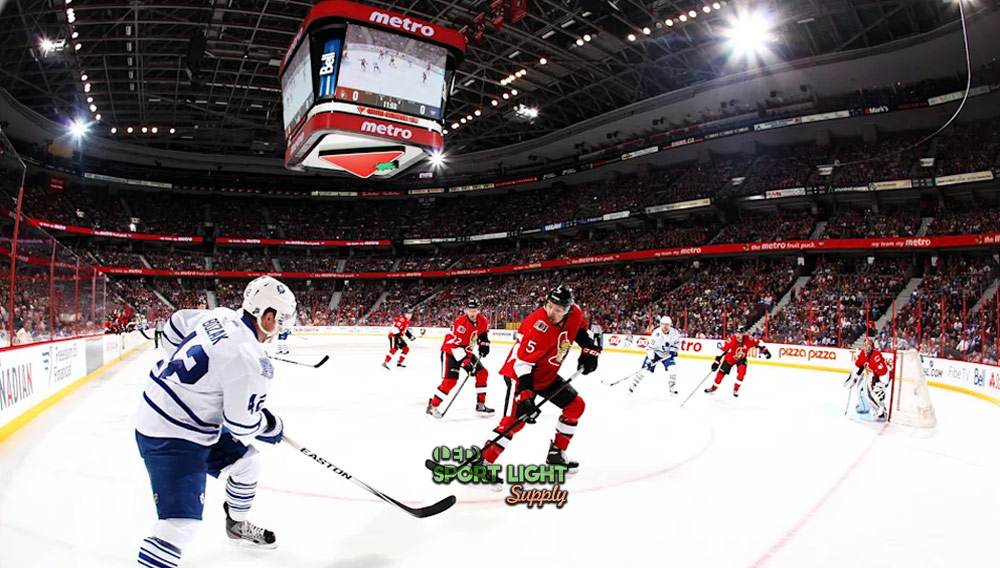
Glare
Minimizing glare is essential to prevent discomfort and visual impairment for players and spectators. Glare can cause distractions and affect players’ focus during critical moments of the game.
Lighting Direction
Proper lighting direction is crucial for reducing shadows and ensuring that the entire rink is evenly illuminated. The lighting system should be designed to minimize any areas of darkness and ensure clear visibility.
Light Quality
The quality of light, including color temperature and Color Rendering Index (CRI), affects how well players and spectators can perceive colors and details. A lighting system with appropriate color temperature and high CRI enhances visibility and helps players distinguish the puck and other elements on the ice.
Reflection on Artificial Ice
Reflection off the ice surface can affect visibility and the overall lighting experience. The lighting system should be designed to manage and minimize reflections to prevent interference with gameplay and viewer experience.
Ice Rink Lighting Requirements
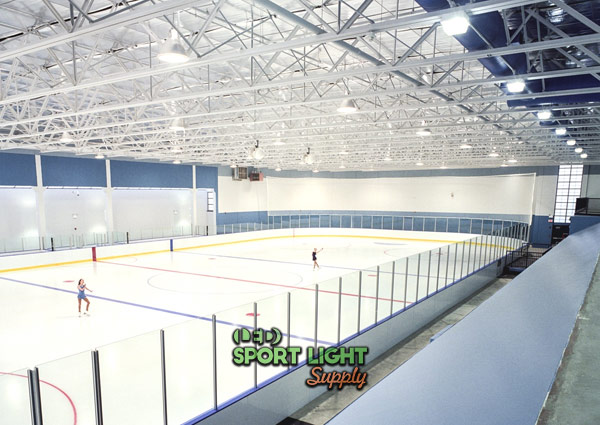
Illuminance Recommendations: Lux and Footcandle Standards
When designing lighting for an ice hockey arena, understanding the difference between lumen, lux, and footcandle is essential. Lumens measure the total output of a light source, while lux measures the illuminance or the amount of light that falls on a given surface area. The lux value changes with distance, making it a critical measure for ensuring adequate lighting in an ice rink. In the United States, the lux requirement may also be expressed in footcandles (fc), where 1 fc equals 10.76 lux.
Horizontal Lux Requirement
Ice hockey rinks must meet specific horizontal illuminance values based on the level of competition. These values ensure that the entire rink is uniformly lit, allowing players to see the puck and each other clearly from all angles. The required lux levels vary depending on the type of event:
| Competition Level | Minimum Horizontal Lux | Equivalent Footcandles |
|---|---|---|
| Professional Championship Leagues | 1,200 lux | 111.5 fc |
| Smaller Leagues | 800 lux | 74.3 fc |
| Local and Regional Matches | 500 lux | 46.4 fc |
| Training and Recreational Use | 250 lux | 23 fc |
Vertical Lux Requirement
Vertical illuminance is also crucial, especially for ensuring that the rink is well-lit from different angles. The following are the vertical lux requirements for various levels of competition:
| Competition Level | Minimum Vertical Lux | Equivalent Footcandles |
|---|---|---|
| Professional Championship Leagues | 800 lux | 74.3 fc |
| Junior Championship Leagues | 500 lux | 46.4 fc |
| 2nd Division and Local Tournaments | 300 lux | 27.9 fc |
| Training | No specific requirement | No specific requirement |
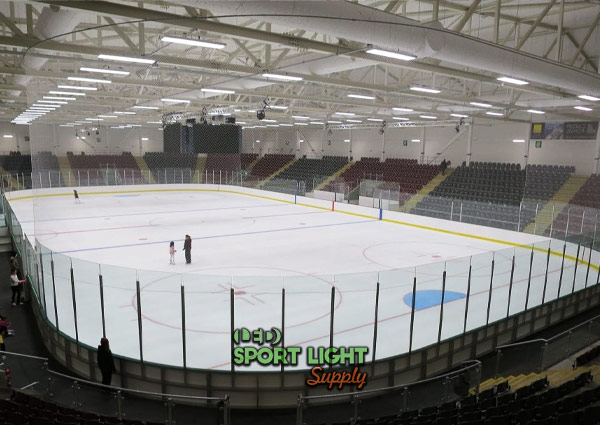
Lighting Uniformity Requirement
Uniformity in lighting ensures that the entire ice rink is evenly lit, without dark spots or overly bright areas. Uniformity is assessed through two metrics: overall uniformity (Uo) and longitudinal uniformity (Ud). These values are calculated by comparing the maximum, minimum, and average lux readings across the rink.
| Competition Level | Horizontal Ud | Vertical Ud | Horizontal Uo | Vertical Uo |
|---|---|---|---|---|
| Professional Championship Leagues | 0.6 | 0.5 | 0.8 | 0.7 |
| Minor Championship Leagues | 0.5 | 0.4 | 0.7 | 0.6 |
| Junior Leagues | 0.4 | 0.2 | 0.7 | 0.4 |
| Training | 0.4 | Not required | 0.6 | Not required |
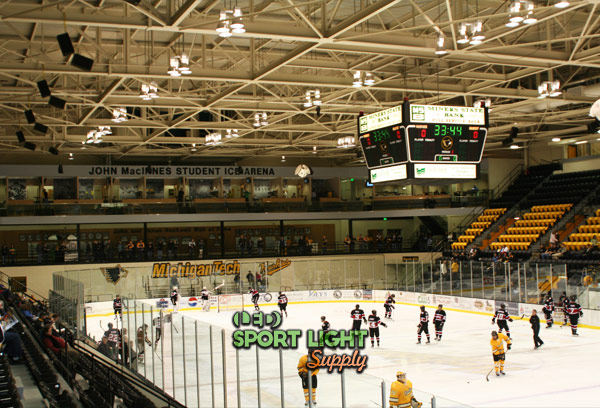
Color Temperature Regulations
The color temperature of the lighting affects how natural the lighting feels and is expressed in Kelvin (K). For ice hockey rinks, higher color temperatures are preferred to mimic daylight, which improves visibility and the overall experience.
| Competition Level | Color Temperature Range |
|---|---|
| Training and Low-Level Competitions | 3,000 K to 5,000 K |
| Junior Championship Leagues | 4,000 K to 6,000 K |
| Professional Championship Leagues | 5,000 K to 6,500 K |
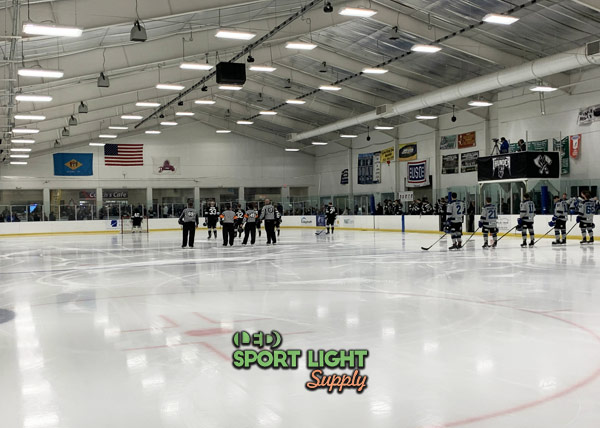
Glare Control
Glare on the ice surface can be distracting and even dangerous for players. Glare control is managed using a GR-method or UGR-method, as outlined in standards like CIE publication 112-1994 and EN 12464-1. Properly shielded fixtures, the correct positioning of lights, and the use of glare shields or longer reflectors are all methods to reduce glare and ensure a clear view for players and spectators alike.
Color Rendering Index (CRI)
The CRI measures the ability of a light source to accurately render colors, which is particularly important for televised games. The following CRI values are recommended based on the level of competition:
| Competition Level | Minimum CRI Requirement |
|---|---|
| Professional Competitions | Over 80 Ra |
| Minor Competitions | 70 Ra |
| Training and Recreational Use | 60 Ra |
Lumen Maintenance Factor (LMF)
The LMF measures how well the lighting quality is maintained over time. Factors such as dust, dirt, and the quality of the installation can affect the LMF. Different light sources and fixtures have varying LMFs, and these should be considered when designing the lighting system.
| Fixture Type | LMF (IP 4X) | LMF (IP 5X) | LMF (IP 6X) |
|---|---|---|---|
| Light Sources ≤ 400 W | 0.60 | 0.65 | 0.70 |
Maintaining the LMF is crucial for ensuring long-term performance and avoiding deterioration in lighting quality. Proper maintenance and selection of fixtures with appropriate IP ratings help mitigate the impact of environmental factors on the lighting system.
FAQ – NHL Ice Arena Regulations
How to Light the Team Benches and Penalty Boxes
Lighting the team benches and penalty boxes is essential to ensure visibility and safety during games. The penalty box, often referred to as the “sin bin,” is where players serve their penalties, giving the opposing team a power play advantage. The team benches, where coaches and players sit, also require proper illumination. Below are the lighting standards for these areas based on the level of competition:
| Competition Level | Required Lux (fc) | Overall Uniformity (Uo) |
|---|---|---|
| Top Championship League | 1,000 lux (93 fc) | 0.8 |
| Minor Championship Leagues | 750 lux (69.7 fc) | 0.7 |
| Local Matches and Tournaments | 300 lux (27.9 fc) | 0.6 |
| Rehearsal and Practice Matches | 150 lux (14 fc) | 0.4 |
It’s crucial to maintain a minimum uniformity level of 0.3 to avoid visual fatigue, even during maintenance periods. Insufficient lighting in the penalty box can impact game performance, especially in the final minutes.
Is There a Recommended Light Source?
While current standards do not mandate a specific light source, they emphasize the importance of choosing energy-efficient options. LEDs are highly recommended due to their eco-friendly nature and absence of heavy metals, unlike HPS and HID lights.
LEDs not only offer strong illumination but also enhance the fan experience with features like dimmable lights for dramatic effects during intermissions or after key plays like a penalty kill. These lights are cost-effective, producing low heat and having a long lifespan, making them ideal for use in ice arenas. Additionally, their small size allows for easy and precise positioning.
What Are the Expected Lighting Life Cycle Costs?
Lighting life cycle costs encompass design, installation, and maintenance over time. Ice rink owners should consider these factors to optimize their investment. Typically, a standard lighting system has a 20-year life cycle.
Brand quality is a significant consideration, as LED lights from different manufacturers can lead to varying energy and maintenance costs. Investing in high-quality lighting systems may reduce the frequency and cost of replacements.
It is advisable for ice arenas, especially those hosting figure skating events, to stock up to an extra 1% of their LED lights. This ensures that replacements are readily available, maintaining compliance with lighting requirements and minimizing downtime. Regular quality control is essential, and stocking the same type of lighting products ensures consistency in performance.
Conclusion
By adhering to the specific lighting requirements for different areas, such as the team benches and penalty boxes, and choosing energy-efficient, long-lasting light sources like LEDs, arena owners can ensure a high-quality environment for both players and spectators. Investing in the right lighting system not only meets regulatory standards but also supports long-term cost efficiency and maintenance ease.
